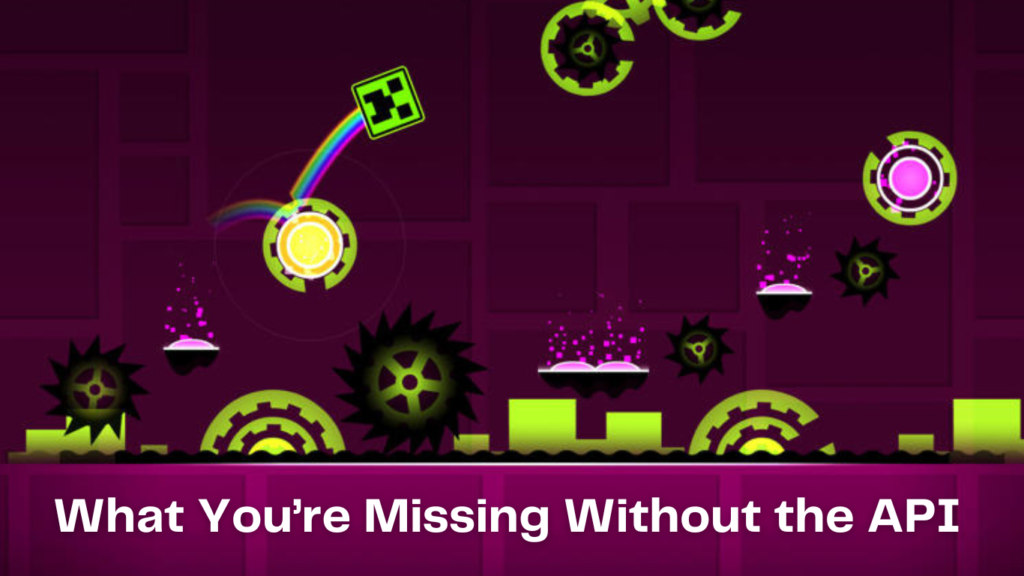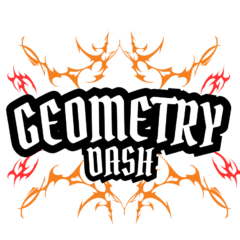Discovering the Hidden Layer Behind a Popular Game
If you’ve spent an entire day tapping spikes, flying over saw blades, and making dreams in Geometry Dash you’re not alone. What makes the game so addictive is not just the rhythmic platformer mechanics.
Because it’s the large community of creators and players who have made it into an artistic outlet. What would happen if I told you that under the bright neon levels and hard jumps, there is a whole world of data waiting to be discovered?
And that’s where the Geometry Dash API is it’s a secret passageway into the engine room of your favorite game.
Static Gameplay Limits Your Exploration
If you’ve spent an entire day tapping spikes, flying over saw blades, and making dreams in Geometry Dash you’re not alone. What makes the game so addictive is not just the rhythmic platformer mechanics.
Because it’s the large community of creators and players who have made it into an artistic outlet. What would happen if I told you that under the bright neon levels and hard jumps, there is a whole world of data waiting to be discovered?
And that’s where the Geometry Dash API is. it’s a secret passageway into the engine room of your favorite game.

What You’re Missing Without the API
Let me paint a picture. You’ve spent days mastering a level, collecting all the secret coins, and climbing the leaderboards, but now you want to build a website to show off your progress.
Or maybe you’re curious about how many attempts it took other players to clear a particular monster map. At that point, you’re no longer dependent on taking screenshots, counting things manually, or third-party trackers.
This lack of direct access not only hinders developers and enthusiasts, it also limits the evolution of the experience for the wider community. The data is there – it’s just locked away behind a wall.
Unlocking the Geometry Dash API
How do I get the API — specifically the GeometryDash API? In other words, how do you get the API — specifically the GeometryDash API? In simple words: how do you communicate with the two apps? And how do third-party tools, programs (and custom apps) get useful data out of the Geometry Dash servers? It’s not imaginary. There are already libraries and open-source projects that
are fully built on this kind of concept. You can get stats on player players (stars, coins, rank), you can get levels, and you can pull leaderboard positions in real time, all on that API. It’s not documented yet, but I think the community has done enough reverse engineering to expose this huge potential.
Exploring What You Can Do With the API
For starters, you can create websites that track the progress of your favorite game, display your winnings, and compare your performance with other players in your country.
Want to know how many people have beaten a particular level? Or how does a custom level classify globally? Now you can get that data. Want to build a cool Discord bot that pings you every time a new challenge drops? Doable.
The API opens the door to integrations that the core gameplay experience does not allow.
Personal Use Case: How I Built a Leaderboard Tracker
From personal experience, one of my favorite uses of the GeometryDash API is to build a small leaderboard tracker. I used it to monitor the top players, how many stars they collected, and which hardest level they were clearing each day. Using just a little bit of code and access to this data, I can get the details of the top 50 positions and even show how many hidden gems they found between custom levels. The best part? I didn’t need to modify the game – just use the API endpoints and look at the info roll.
Going Deep: Building Tools, Not Just Tracking
The API doesn’t just let you track. It lets you build. You can create fully interactive programs that give players a deeper connection to the game. A friend built a web tool that shows your Secret Coin progress across all the major levels. Another built a bot that detects level trends based on game-level metadata. Something like Geometry Dash gives you an amount of creativity with which you can interact. Tools like these make communities better and more connected.
Why This Matters for the Future of Geometry Dash
Let’s get real. Games like Geometry Dash would not survive as well, if the communities for them were not happy. By linking this community to your data with a API such as interface, this community is able to generate all of these new projects.
Entrepreneur building system which will sign for duration & together will record the progress that within game.The upcoming major update of Geometry Dash will contain official API support.
An opportunity like that will come, Die XBOX One-UI ist beim größtenteils eher nostalgischem Gefühl von schrecklich-oft-dieses-ginge-auch gut-malnachher (also die 2x rückwärtszwinker-Workarounds und einige Aktionen würde man nehmen, was die horrende Entwicklungszeit mergodnerts etwas hätte sparen können) wird doch eher vermuten lassen, dass die Zukunft ist, indem das Öffnen hervorbringt – von diesen auch mal graswurzleBig Unterforderungs Status-Dashboards bis zu smart level Advis
.
You Don’t Need Permission to Explore
Today , good news is , no waiting for this September official date from RobTop There are already real APIs created , will be posted in forums , and that is guides detailed .
I Think, You miss 1 Snippet of Curiosity , 1 Snippet of Programm Basic Think , Want to look Inside.. If U wanna show U top scores, make stat based level selector or simple better progress view,
The Geometry Dash API is the path to getting there. Behind that hidden door lies the world with your fingers as the driver.
Can you give examples of other API requests?
Absolutely! Here are some additional examples of Geometry Dash API requests and what they can achieve. I’ll break it down in a way that’s easy to understand:
1. Fetching Daily Levels
Endpoint: /getGJDailyLevel
If you want to know what the daily featured level is, this endpoint is your go-to. Here’s how it works:
Example Request:
Python
import requests
url = “https://geometrydashapi.com/getGJDailyLevel”
response = requests.get(url)
if response.status_code == 200:
daily_level = response.json()
print(f”Today’s featured level: {daily_level[‘level_name’]}, Difficulty: {daily_level[‘difficulty’]}”)
Else:
print(“Could not fetch daily level.”)
This will return details about the current daily level, including its name, difficulty, and creator.
2. Searching for Levels
Endpoint: /getGJLevels
Sometimes players want to find specific levels based on keywords, themes, or popularity. Using this endpoint, you can retrieve a list of levels matching your search.
Example Request:
Python
import requests
url = “https://geometrydashapi.com/getGJLevels”
params = {“search_query”: “challenge”} # Search for levels with “challenge” in their name
response = requests.get(url, params=params)
if response.status_code == 200:
levels = response.json()
For level in levels:
print(f”Level Name: {level[‘name’]}, Downloads: {level[‘downloads’]}”)
Else:
print(“Could not fetch levels.”)
This request will provide a list of levels that match the search query “challenge,” along with their download counts and other details.
3. Retrieving Player Stats
Endpoint: /getGJUserInfo
Want to check your stats or a friend’s? This endpoint fetches all the juicy details like stars, coins, and rank.
Example Request:
Python
import requests
url = “https://geometrydashapi.com/getGJUserInfo”
params = {“player_id”: 789456} # Replace with actual player ID
response = requests.get(url, params=params)
if response.status_code == 200:
player_info = response.json()
print(f”Player Name: {player_info[‘name’]}, Stars: {player_info[‘stars’]}, Rank: {player_info[‘rank’]}”)
Else:
print(“Could not fetch player stats.”)
This gives you an overview of the player’s performance.
4. Downloading Specific Levels
Endpoint: /download level
If you know the level ID and want detailed information about it, this endpoint is helpful.
Example Request:
Python
import requests
url = “https://geometrydashapi.com/downloadGJLevel”
params = {“level_id”: 123456} # Replace with the level’s unique ID
response = requests.get(url, params=params)
if response.status_code == 200:
level_data = response.json()
print(f”Level Name: {level_data[‘name’]}, Creator: {level_data[‘creator’]}”)
Else:
print(“Could not fetch level data.”)
This will provide details about the level, including its creator, difficulty, and more.
5. Fetching Timely Levels
Endpoint: /getGJWeeklyLevel
Like the daily level endpoint, this one provides information about the weekly featured level.
Example Request:
Python
import requests
url = “https://geometrydashapi.com/getGJWeeklyLevel”
response = requests.get(url)
if response.status_code == 200:
weekly_level = response.json()
print(f”This week’s featured level: {weekly_level[‘level_name’]}, Difficulty: {weekly_level[‘difficulty’]}”)
Else:
print(“Could not fetch weekly level.”)
You can use this to stay updated with weekly challenges.
6. Fetching Leaderboard Data
Endpoint: /getGJTop100
This one we talked about last time but since you missed it is the way to determine stats of 100 players worldwide.
Here is a little piece of list this to give examples of items you can submit on Geometry Dash. You can wire up endpoint in amazing ways to create over incredible tool such as leaderboard, level browser or community dashboard.
Why are rate limits important in API usage?
Rate limits are very important for API performance, they help keep the whole organization running smoothly, and keep the server from becoming too busy The basic list of reasons why rate limits are so important:
1. Preventing Server Overload
As long as there are too many requests being sent to the server in a certain amount of time, it will be overloaded and crash/slow down a lot. So there is a rate limit on how many requests the server can take per user to keep the API stable for everyone.
2. Fair Usage
APIs are usually shared by several people and rate limits prevent one person from using too many resources. Like in a queue; rate limits prevent one person from consuming too much of the resource instead of one individual using it all.
3. Protecting Against Abuse
The purpose of rate limits is to prevent abuse ( e. g. bots creating thousands of spam requests to send servers). By limiting the number of requests that can be sent the APIs can deter malicious activity and keep integrity.
4. Managing Costs
Having an API hosted can be expensive (especially if lots of traffic means more servers are needed) so rate limits help with operational costs and resource utilization.
5. Ensuring Stable Performance
If you are using the Geometry Dash leaderboard as an example, if they have no rate limit on the API you could get thousands of requests at once and get delays or error messages from them. Rate limits keep the requests small and allow for more consistent service.











